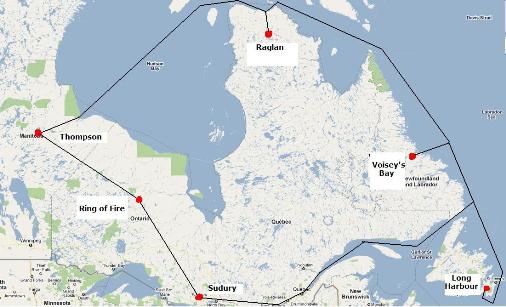Canadian Mining Review: Discussing ideas and issues related to mining in Canada
Our national mineral development strategy should include a requirement
to use mineral resources to our advantage by processing them prior to export.
(Patrick Whiteway)
The close proximity of Ontario’s Ring of Fire, Manitoba’s Thompson Nickel Belt and low carbon-emitting hydro power, give Canada an unparalleled opportunity to become a long-term, sustainable producer of stainless steel, the enviro-metal. If only the sustainability of the northern boreal forest could be assured as well.
Massive deposits of chromite and nickel have been discovered in the ‘Ring of Fire’ under the boreal forest of northwestern Ontario and plans by Cliffs Natural Resources and Noront Resources respectively to develop them are well underway. How this development is managed by the federal and provincial governments could be historically significant for resource development in Canada.
The scale of the undertaking is huge. It could, in the next 10 years, create Canada’s first chromite mine and with an appropriate level of visionary leadership, could also transform Canada into the lowest-carbon-emitting source of stainless steel on the planet.
What does stainless steel have to do with mining nickel and chromium? Well, almost all of the inputs needed to make stainless steel – nickel, chromium, iron and low-carbon emitting hyro-electric energy – are readily available within a 500 km radius of the Ring of Fire.
What is not in place is a co-operative agreement with the native people of northwestern Ontario and a commitment on the part of the key corporate players to protect the source of these people’s livelihood – the boreal forest. That could be a deal breaker.
A feasibility study to construct a $2-billion railway to link the isolated northern property to existing infrastructure just north of Lake Superior is expected soon.
For all Canadians to benefit from this unprecedented opportunity, a high level of inter-provincial cooperation is needed.
Is Canada’s national policy on mineral development sufficiently equipped to guide this process?
At the present time, Canada’s national mining policy does NOT include a requirement for companies developing mineral resources to so everything possible to add value to those resources before exporting them to other countries. It should.
That would mean metal “concentrates” could not be exported and the amount of processing done here in Canada would be maximized, including the processing of chromite and nickel into stainless steel which could then be exported.
Game-changing hydro electric developments are presently taking place in Manitoba. And, over the next few years, as the world’s major economies adopt some form of carbon tax or cap-and-trade system for managing carbon emissions, this source of electrical power will give Canada a distinct competitive advantage in the global economy.
For the rest of this column, please go to the Canadian Mining Review Blog: http://www.canadianminingreview.com/

























